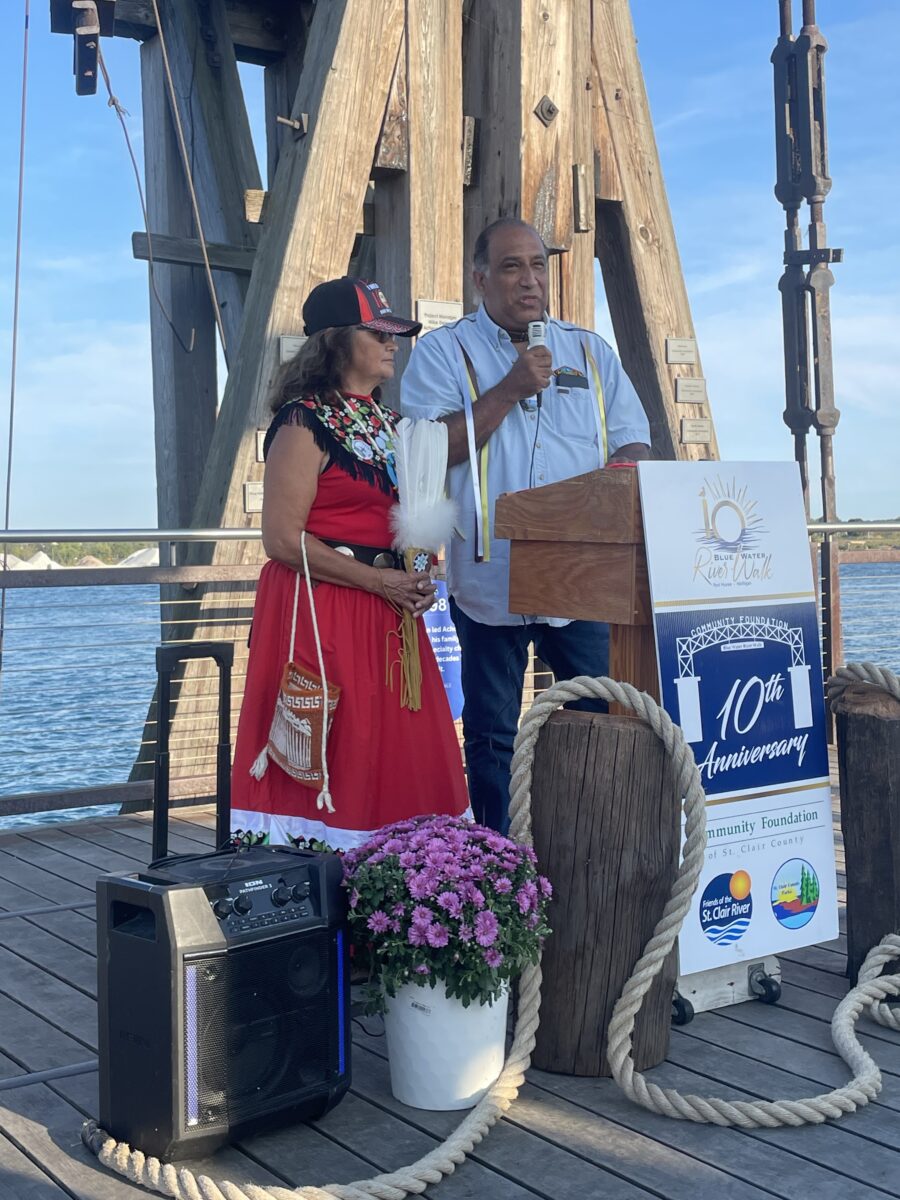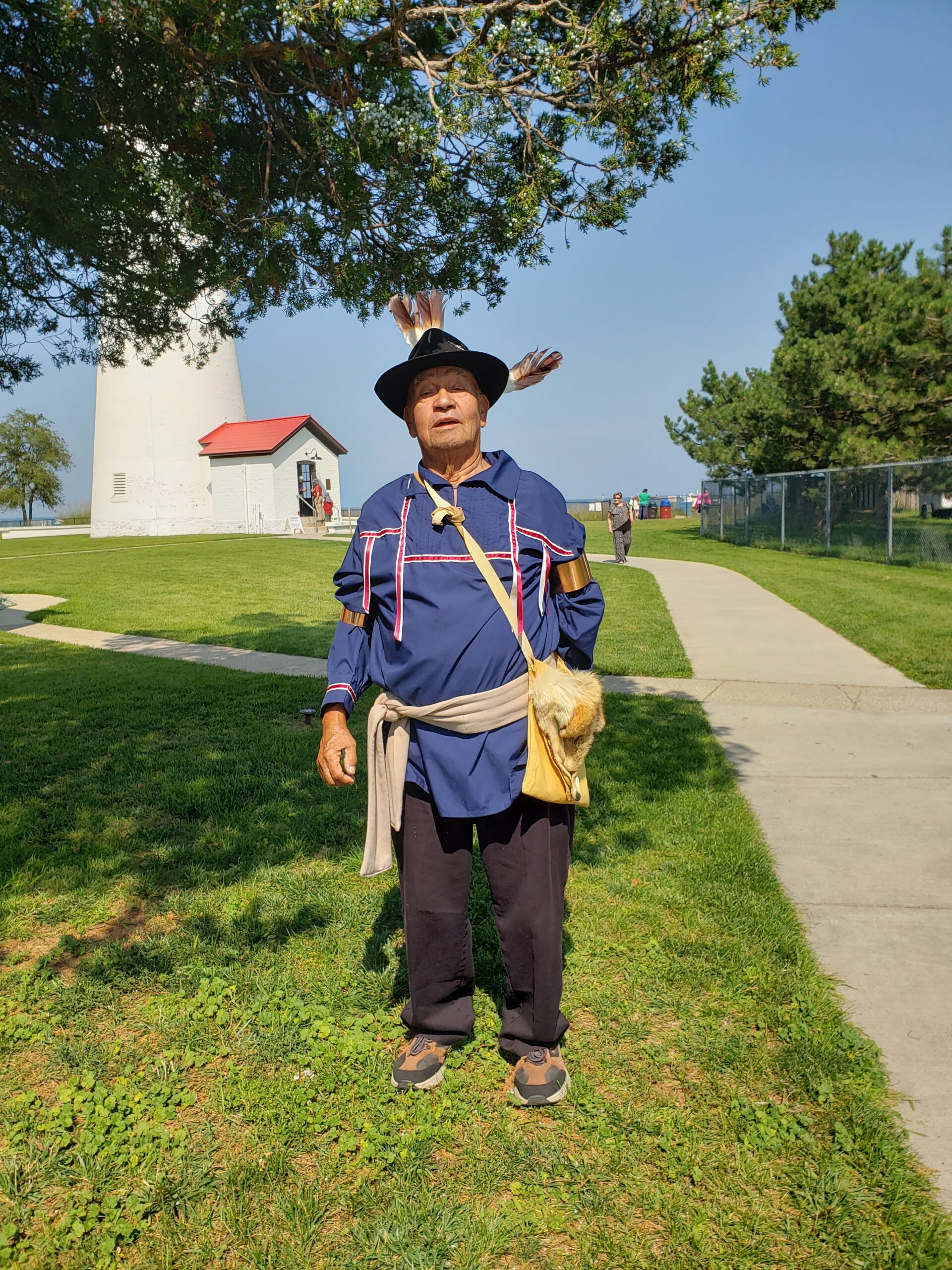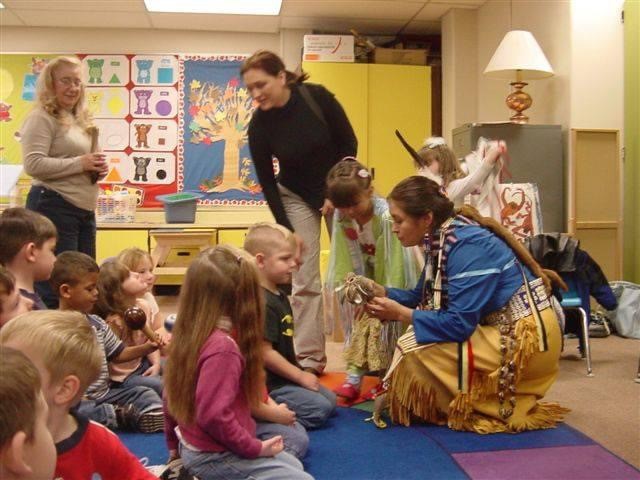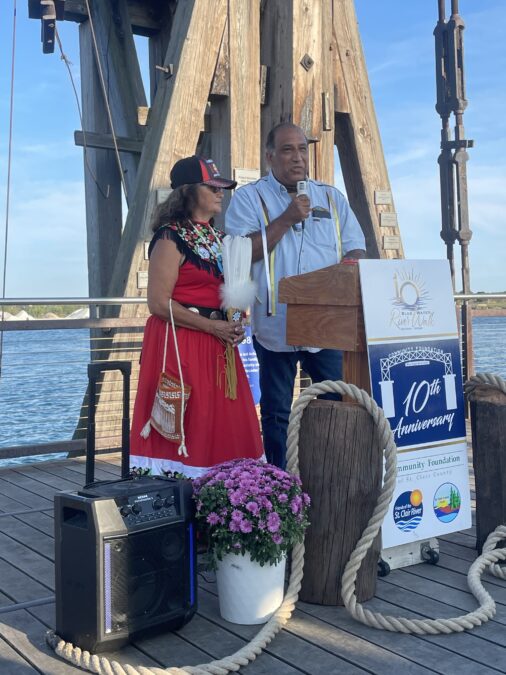By Laura Fitzgerald
Dressed in traditional indigenous clothing, Joan and Joe Jacobs, of the North American Indigenous Council (NACI), acknowledged their ancestors on the banks of the St. Clair River before a crowd gathered for the 10th anniversary of the Blue Water River Walk.

“We acknowledge the ancestors that stretch back generations,” Joan Jacobs said.
This was more than just a simple statement. The Jacobs honored the historic and present-day contributions of their people, who have inhabited the Blue Water Area for thousands of years.
The land acknowledgement statement was indicative of efforts in recent years from local indigenous people and institutions who have made strides in educating the general public about indigenous culture and history. However, challenges in securing funding for these programs persist.
The area around the Great Lakes is inhabited by the Three Fires Confederacy: Ojibway (Chippewa), Odawa (Ottawa) and Odawatomi (Potawatomi). Eastern Michigan was home to the Sawn Creek, Black River and Saginaw bands of Ojibway.
There are 12 federally-recognized tribes in Michigan today, which have special status that allow these nations to operate as sovereign governments with direct jurisdiction over their own citizens and territories.
Challenges in Securing Funding Persist
The absence of a federally-recognized tribe in the Blue Water Area makes securing funding more challenging.
“One of the main challenges Native-serving organizations face is that traditional funding streams often overlook communities not tied to federally recognized Tribes. This results in fewer resources for cultural, educational, and social services,” said Greg Masten, President of the NACI Foundation. “At the Foundation, we support these organizations through financial and structural assistance, acting as a load-bearing partner. Our goal is to empower these organizations to advocate for sovereignty and self-determination, ensuring that Native people, regardless of where they live, have the resources to thrive as citizens of their sovereign Nations.”
Becky Kennedy, a member of the First Nations Oneida of the Thames Tribe, chairs the committee that organizes the annual Blue Water Pow Wow and is a member of the local NACI chapter.
Kennedy echoed Masten’s comments, and added fundraising efforts are often limited by the time and manpower of the all-volunteer committees who lead indigenous organizations.
Kennedy said volunteers also have the challenge of ensuring that donors – including corporate donors – have practices and values that are culturally sensitive and respectful to indigenous peoples.

Despite these challenges, Becky and her father, John Kennedy, brought back the Pow Wow in 2019 through a grassroots campaign, grants and partnerships with the Community Foundation of St. Clair County and the Port Huron Museums. The Pow Wow was a big event in the 90s and early 2000s, Kennedy said, but was discontinued because of a lack of funding.
Today, the annual event costs about $8,000 to produce.
The Blue Water Pow Wow features indigenous dance, food, art, music and vendors at the Fort Gratiot Lighthouse.
“The main goal of the Pow Wow is to gather with our friends and family, to celebrate each other, enjoy our company and to dance. Dancing is our form of prayers and healing. It’s also about just being together again and celebrating what, at one point, was taken away from us through colonization,” Kennedy said. “And then the other goal is to bring knowledge to the community of our traditions. It’s to say, we are still here as a people. We’re not people of the past. We are here now.”
Local educational institutions also face a lack of capacity when creating programs that educate the public about indigenous history and culture.
“We would love to create an in-depth, interactive, professional exhibit at the Carnegie Museum that tells the story of the indigenous people that live here and how they lived. We talked to our indigenous community members about that, and they would love to have something here,” said Port Huron Museums Director Veronica Campbell. “But, funding an exhibit like that is a lot, and that’s not necessarily in the museums’ scope at this time.”
Campbell said the cost of such an exhibit might run somewhere around the $130,000 price tag of the museums’ most recent exhibit at the Fort Gratiot Hospital.
Celebrating Indigenous Culture
But despite these challenges, Kennedy said she has seen an awareness of and efforts to celebrate indigenous culture gain momentum in recent years.
The local NACI, which received its nonprofit status about two years ago, will kick off its first major event with St. Clair County Community College on November 7, 2024, from 6:00pm to 7:00pm in the Fine Arts Building for Native American Heritage Month. Port Huron Schools changed their mascot – formerly an insensitive caricature of an indigenous person – after receiving a grant from the Native American Heritage Fund.

Friends of the St. Clair River worked with First Nations and indigenous people in the U.S. and Canada to plant a Giitigan – a garden that honors culturally and medicinally significant plants – on the Blue Water River Walk. The Friends’ annual Sturgeon Festival honors a culturally significant species and food source for indigenous peoples, said Executive Director Sheri Faust.
The Museums have hosted a public nature walk and lecture series with an Anishinabek traditional knowledge keeper and included indigenous peoples on its Stanley Legacy Wall.
Representatives from the NACI said cultural institutions have a responsibility to give local indigenous people a platform to educate the public about their own cultures and history.
“Historically, Indigenous voices have been marginalized or erased in mainstream narratives, often replaced with outsider interpretations. Museums, libraries, conservation efforts, and educational institutions must actively “pass the mic” to Indigenous communities, ensuring that Native voices are at the forefront of telling their own stories. By fostering partnerships with Indigenous organizations and leaders, local institutions can shift from being interpreters of Native history to supporters of Indigenous-led education,” the NACI said.
“This approach acknowledges the sovereignty of Native peoples, ensuring that their history and culture are presented with accuracy, authenticity, and respect. It also allows Indigenous communities to control their own narratives, which is key in preserving their heritage and reinforcing their rights.”
If you would like to make a gift to support Indigenous programs, click here.

